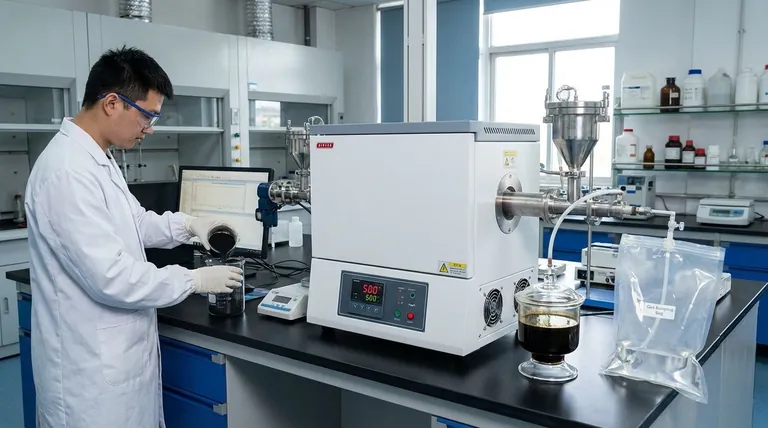In pyrolysis, temperature is the primary control lever that determines the final output. In short, lower process temperatures favor the creation of solid products like biochar, while higher temperatures break the feedstock down further, yielding more liquids (bio-oil) and, at the highest temperatures, non-condensable gases (syngas).
The core principle is that temperature, in combination with the heating rate, dictates the extent to which organic material is decomposed. By controlling these two factors, you can steer the pyrolysis process to selectively produce solids, liquids, or gases to meet a specific goal.

How Temperature Dictates Pyrolysis Products
Pyrolysis is the thermal decomposition of materials at elevated temperatures in an oxygen-deprived environment. Temperature directly controls the speed and depth of the chemical reactions that break down complex organic matter like biomass.
Low Temperature (< 450°C): Maximizing Biochar
At lower temperatures, typically below 450°C (842°F), and with slower heating rates, the process is less aggressive.
This environment gives the organic material time to carbonize. Volatile compounds are driven off, but the core carbon structure remains largely intact, resulting in a high yield of biochar, a stable, solid, carbon-rich material similar to charcoal.
Moderate Temperature (~500°C): Optimizing for Bio-oil
When temperatures are increased to an intermediate range, often around 500°C (932°F), and combined with very rapid heating rates, the primary product shifts.
These conditions, characteristic of "fast pyrolysis," cause the cellulose and lignin in the feedstock to rapidly break down into smaller organic vapors. When these hot vapors are quickly cooled and condensed, they form a dark, viscous liquid known as bio-oil.
High Temperature (> 800°C): Producing Syngas
At very high temperatures, above 800°C (1472°F), the thermal cracking is so intense that nearly all organic matter is broken down into its simplest molecular components.
This process, sometimes bordering on gasification, maximizes the production of non-condensable gases. The resulting product is syngas, a mixture primarily composed of hydrogen (H₂) and carbon monoxide (CO), which can be used as a gaseous fuel.
Understanding the Key Variables
While temperature is the primary driver, it does not act in isolation. Achieving a desired outcome requires managing several interrelated factors that influence how heat is transferred and how the material decomposes.
The Critical Role of Heating Rate
The speed at which the target temperature is reached is just as important as the temperature itself.
A slow heating rate allows for char formation, even at higher temperatures. Conversely, a rapid heating rate is essential for producing bio-oil, as it cracks the material into vapors before it has a chance to form a solid char structure.
The Impact of Feedstock Properties
The physical state of your input material, or feedstock, is critical for efficient heat transfer.
Most pyrolysis systems require a small particle size (often under 2 mm) to ensure the material heats uniformly and quickly. A high moisture content (ideally below 10%) is also detrimental, as the system must waste energy boiling water before pyrolysis can begin.
Residence Time as a Fine-Tuning Tool
Residence time—how long the material is held at the target temperature—is another key variable. Longer residence times allow decomposition reactions to proceed further, which can increase gas yields at the expense of liquids and solids.
Steering Pyrolysis for Your Desired Outcome
Your operational parameters should be set based on the product you intend to create. By manipulating temperature and its related factors, you can reliably control the output of your process.
- If your primary focus is producing biochar: Use lower temperatures (< 450°C) with slow heating rates to maximize the solid yield.
- If your primary focus is creating bio-oil: Use moderate temperatures (~500°C) with very rapid heating rates and quick vapor condensation.
- If your primary focus is generating syngas: Use very high temperatures (> 800°C) to ensure complete thermal cracking of the feedstock into gas.
Mastering these relationships transforms pyrolysis from a simple process into a precise manufacturing tool.
Summary Table:
| Target Product | Optimal Temperature Range | Key Conditions |
|---|---|---|
| Biochar | < 450°C (842°F) | Slow heating rate |
| Bio-oil | ~500°C (932°F) | Rapid heating, quick condensation |
| Syngas | > 800°C (1472°F) | High-temperature thermal cracking |
Ready to optimize your pyrolysis process for maximum yield?
At KINTEK, we specialize in precision laboratory equipment, including pyrolysis reactors and furnaces, designed to give you exact control over temperature, heating rate, and residence time. Whether your goal is to produce biochar, bio-oil, or syngas, our solutions help you achieve consistent, high-quality results.
Contact our experts today to discuss how we can tailor a system to meet your specific pyrolysis needs. Get in touch via our contact form to start the conversation.
Visual Guide

Related Products
- Vacuum Sealed Continuous Working Rotary Tube Furnace Rotating Tube Furnace
- Electric Rotary Kiln Small Rotary Furnace Biomass Pyrolysis Plant
- Laboratory Quartz Tube Furnace Tubular RTP Heating Furnace
- 1200℃ Controlled Atmosphere Furnace Nitrogen Inert Atmosphere Furnace
- 1700℃ Muffle Oven Furnace for Laboratory
People Also Ask
- What is the temperature range for pyrolysis? Optimize for Biochar, Bio-oil, or Syngas
- What is the temperature of a rotary hearth furnace? Find the Right Heat for Your Process
- What is the range of pyrolysis? Master Temperature Control for Optimal Bio-Product Yields
- How do you convert biomass into energy? A Guide to Thermochemical and Biochemical Methods
- What is the heat required for pyrolysis? Mastering Energy Input for Optimal Biochar, Bio-Oil, or Syngas



















